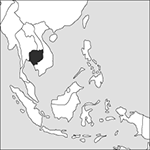
Source: MAPS IN MINUTES™ © RH Publications (1997)
Capital:
Phnom Penh
Area:
181,035 sq km (69,898 sq miles)
Population:
15,205,539 (2012 est)
Currency:
1 riel = 100 sen
Religions:
Buddhist 96.4%; Muslim 2.4%
Ethnic Groups:
Khmer 90.0%; Vietnamese 5.0%; Chinese 1.0%
Languages:
Khmer (official); French; English
International Organizations:
UN; ASEAN; Non-Aligned Movement; WTO
A tropical country in south-east Asia flanked by Thailand, Laos, and Vietnam.
Physical
Through it from the north flows the Mekong, while westward is a large lake, the Tonlé Sap. The climate is tropical monsoon, and most of the land marshy or forested. A short coastline faces south-west on the Gulf of Thailand.
Economy
The prolonged civil war and the Khmer Rouge regime’s policies of resettlement decimated the economy but there has since been a significant recovery, with considerable growth in the 21st century. Clothing is the principal export, and tourism is growing rapidly. Offshore oil reserves were discovered in 2005 but have yet to be exploited. Agriculture remains the principal employer and poverty remains widespread.
History
Cambodia was occupied from the 1st to the 6th century ad by the Hindu kingdoms of Funan, and subsequently Chenla. The Khmer people overthrew the Hindu rulers of Chenla and established a Buddhist empire, centred around the region of Angkor. The classical, or Angkorean, period lasted from 802 to 1432, with the Khmer empire reaching its peak during the 12th century. After 1432 the empire went into decline and suffered frequent invasions from Vietnam and Thailand. Continuing foreign domination forced Cambodia to seek French protection in 1863, and from 1884 it was treated as part of French Indo-China, although allowed to retain its royal dynasty. After Japanese occupation in World War II, King Norodom Sihanouk achieved independence within the French Union (1949) and full independence in 1953. Sihanouk abdicated in 1955 to form a broad-based coalition government. Cambodia was drawn into the Vietnam War in the 1960s, and US suspicions of Sihanouk’s relations with communist forces led to his overthrow by the army under Lon Nol in 1970, following a US bombing offensive (1969–70) and invasion. The Lon Nol regime renamed Cambodia the Khmer Republic. The regime soon came under heavy pressure from the communist Khmer Rouge. Following the fall of Phnom Penh in 1975, the Khmer Rouge under Pol Pot renamed the country Democratic Kampuchea and launched a bloody reign of terror, which is estimated to have resulted in as many as two million deaths, or nearly a third of the population. Border tensions led to an invasion of the country by Vietnam in 1978, and the overthrow of the Pol Pot regime two weeks later. The Vietnamese installed a client regime under an ex-Khmer Rouge member, Heng Samrin, who proclaimed a new People’s Republic of Kampuchea, but conflict with Khmer Rouge and other guerrilla groups continued until 1987, when peace talks began in Paris. In 1990 a peace agreement ended 13 years of civil strife. A UN Transitional Authority enforced a ceasefire and installed an interim Supreme Council, under Prince Norodom Sihanouk as head of state. The Council included representatives of the former government—the Cambodian People’s Party (CPP) led by Hun Sen—and the former guerrilla movements. Multiparty elections were held in 1993. No party won a clear majority of seats, but a democratic monarchist constitution was adopted; Sihanouk became king and a coalition government was formed with Hun Sen and Norodom Ranariddh, son of Norodom Sihanouk and leader of the National United Front (NUF), becoming co-premiers. The Khmer Rouge refused to participate in the elections and continued to launch guerrilla attacks for some years; by 1999 it was effectively quiescent. In 1997 Prince Ranariddh was ousted by Hun Sen’s followers, who were victorious in elections the following year. Hun Sen remained Prime Minister following the elections of 2003, 2008 and 2013. Hun Sen’s rule had become increasingly authoritarian. In 2004 Sihanouk abdicated and was succeeded by his son Norodom Sihamoni. In 2009, the tribunal for former Khmer Rouge officials for crimes against humanity eventually started. Five people were charged, but not Pol Pot who died in 1998. In 2010 Kang Kek Iew was found guilty as were Nuon Chea and Khieu Samphan in 2014. All were sentenced to life in prison. The two remaining defendants died before their trials were completed. In 2018 Chea and Samphan were found guilty of genocide and again sentenced to life imprisonment.
- divaricator muscle
- diverge(divergent)
- divergence
- divergence angle
- divergence indicator
- divergence theorem
- divergent evolution
- divergent margin
- divergent series
- diverging lens
- diverging lens or mirror
- diverging margin
- diverse economies
- diverse programming
- diversification
- diversity
- diversity index
- diversity system
- diverticulum
- divestment
- divide
- divide and conquer sorting
- divided difference
- divided line
- dividend